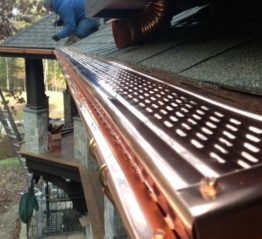Prevent Ice Dams Before They Form
Ice dams form when the snow melts off of your roof and refreezes near the edge. This happens when your roof is above freezing temperature, which is usually the result of a warm attic.

In almost every home, heat escapes through ceilings into the attic and warms the roof directly above it.
The outdoor temperature may be below freezing, but a warm attic can melt the snow. The edge of your roof is not warmed by the attic, and so when the icemelt hits that area, it refreezes, creating a rim of ice. This chunk can grow, trap water behind it and suddenly you have an ice dam.
One easy way to prevent this is to keep your roof cold. This may seem obvious but impossible, so we’ve put together a few ways to best keep your roof from warming too rapidly.
1. Close up attic bypasses
One-third of the heat loss is through the ceiling into the attic of the average home. Most of that heat loss comes from air leaks caused by unblocked walls, gaps in drywall, cracks around light fixtures, plumbing pipes, chimneys, and access hatches
Air leaks can be tough to stop, but not impossible. If you can plug the leaks under your attic insulation with foam, caulk, or other methods, it becomes fairly easy. Give us a call today to discuss how we can help you close up your attic bypasses.
2. Increase your attic insulation level
Your attic insulation should have 12 to 14 inches of fiberglass or cellulose. If you have less than 8 inches, you may have noticed ice dams in the past. Contact George’s Seamless Gutters to discuss installing new insulation in your attic.
3. Add roof and soffit vents
Attic vents draw in cold outdoor air and flush out warmer attic air, cooling the attic and the roof. Discuss adding roof and soffit vents with us today and we can work together to find the best style and size for your home.
Of course, a cold roof isn’t always the easiest solution. During winters with very heavy snowfall (remember that polar vortex?), you may still get ice dams, regardless. Some sections of your roof may even be impossible to keep cold. That’s when further strategies help to prevent ice dam damage.















